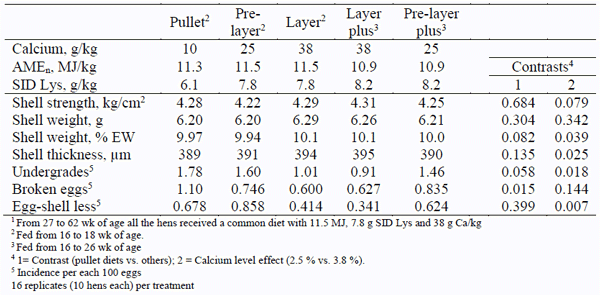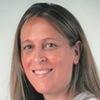1. INTRODUCTION
Consumer demands and the pressure of supermarket chains are changing rapidly the way eggs are produced. Enriched cages are not considered a sound alternative to improve animal welfare standards in the developed countries. Consequently, the industry is moving hens from battery cages towards alternative systems, such as deep litter and aviary barns, with or without access to an outdoor area. In addition, organic production with non-beak trimmed hens, under free range conditions, is gaining popularity. In 2018, the percentage of hens reared under these systems in key countries of the European Union (EU-28) is shown in Table 1 (European Commission, 2019).
Table 1 - Alternative systems for laying hens by country. European Union-28, 2018.
Of note is the growing interest for organic and free-range production systems in Northern Europe as compared with the relative high percentage of caged hens in the Eastern and Southern parts of Europe. Historical data on the production systems in Spain, a key country in egg production in Europe, are shown in Table 2. From 2016 to 2018 the percentage of caged hens decreased from 92.9 % to 82.3 %. A greater rate of change is expected for the next 2-3 years.
Table 2 - Alternative systems for egg production in Spain. Historical data.
Egg production in alternative systems requires expertise on behaviour and management of the birds. Nutrition is, after management, the main factor to control in modern egg production (Ruhnke, 2015). Areas of concern (and requiring improvement) in practice, include a) maximize feed intake (FI), especially in small frame hens exposed to the environment and with high physical activity, b) increase BW uniformity of the flock to decrease safety margins in feed formulation, c) reduce the incidence of feather pecking and cannibalism to increase liveability and animal welfare and d) produce high quality eggs of adequate size for the first months and good shell quality for the last months of the egg cycle (van Krimpen et al., 2005; Ruhnke, 2015; Lohmann, 2017; van Emous and van Krimpen, 2019; Kaukunen and Valros, 2019; Iqbal et al., 2019).
II. MAXIMIZING FEED INTAKE
The goal of all the alternative systems is to optimize hen production to reach similar performance to that of caged hens at similar cost. In general, hens reared under alternative systems lose weight during the first 2 to 3 wk of the pre-peak period (entry into the barn) and thus, maximising body weight (BW) of the pullets before the onset of egg production is a sound management and nutritional strategy. Maintenance requirements are higher for hens in alternative systems than for hens in cages, especially in aviaries with access to an outdoor area. At low ambient temperature, hens consume energy to maintain body temperature resulting in poor feed efficiency, a problem that is aggravated in flocks with poor feather cover. Peguri and Coon (1993) reported differences in feed intake (FI) from 82 g/d in well feathered hens under heat stress conditions (33.9 ºC) to 147 g/d in totally de-feathered hens at 12.8 ºC (Table 3). On the other hand, good feather cover might reduce energy intake below requirements of laying hens under hot weather conditions. Under these circumstances, an increase in the energy content of the diet, or changing feed form from mash to crumbles, might help to solve the problem.
Modern lines of laying hens have been selected for years for reduced frame size and for increased persistency in egg production. Thus, feed efficiency has improved but the intake capacity of young hens, under stressful situations, might not be sufficient to meet nutrient requirements. As a consequence, hens lose BW with a subsequent reduction in egg size and egg production. Data in Table 4 illustrate that maintenance needs of aviary hens with access to the outdoors might be up to 10 to 15 % higher than those of caged hens. However, it should be noted that the energy requirements for egg production with mash diets are similar for all systems.
Table 3 - Influence of ambient temperature and feather cover on feed intake in Single Comb White Leghorn hens.
Table 4 - Energy requirements of laying hens for optimal egg production. A comparative study.
Three strategies used to overcome the problem of low FI at the start of the egg cycle under stress conditions are 1) apply the empty feeder technique, 2) improve feed structure of the diet and 3) increase the fibre content of the pullet diet from 10 to 17 wk of age. The empty feeder technique consists of training the pullets (after 4 to 5 wk of age) to consume as much feed as possible. Immediately after the lights go on, an extra amount of new feed is placed in the feeders as needed. At mid-day, pullets are forced to clean the feeders, consuming all fines left in the feeders for 60 min. Then, new feed is supplied 2 to 3 times during the afternoon, until the lights go off. A similar strategy should be used in the laying hens to ensure that at least 60 % of the feed (and Ca) is consumed in the afternoon, resulting in an increase in BW gain and shell quality during the entire egg cycle.
Feed form, average mean particle size (MPS) and feed uniformity affect FI in all types of birds (Röhde et al., 2014). Usually, pullets and laying hens are fed mash diets because of cost and the apparent lack of benefit of pelleting (or crumbling) on performance. The use of crumbles, however, might be recommended under some circumstances, such as pullets from 0 to 5 wk of age, and light hens at the start of laying cycle (15 to 25 wk of age). Feeding high quality crumbles during the prestarter period increases BW gain and uniformity as well as feed efficiency (Frikha et al., 2009a,b; Guzmán et al., 2015). Also, young hens fed low energy diets, under hot weather conditions, might benefit of the use of crumbles during the pre-peak period. However, feeding crumbles jeopardizes the development of the gastrointestinal tract (GIT), reducing future voluntary FI, a current situation at the initial stages of the egg cycle (Saldaña et al., 2015a, b). Under these circumstances, the inclusion in the diet of insoluble fibre sources might help to overcome the problem.
It is accepted that laying hens show a preference for consuming coarse vs. fine particles (Portella et al., 1998; ISA Brown, 2008; Safaa et al., 2009) which, in turn, might result in an increase in egg production and egg weight (Table 5). The data available, however, do not show a clear, linear, positive relation between MPS of the diet and voluntary FI and egg production of laying hens under commercial practices (Hamilton and Proudfoot, 1995; Ege et al., 2019). Herrera et al. (2017, 2018a) reported a preference of laying hens for coarse particles but the preference did not result in an increase in hen production (Tables 6 and 7).
Table 5 - Influence of particle size of the diet on feed intake and egg production in brown laying hens.
Table 6 - Preference of brown egg laying hens for the coarse particles of the diet1 (geometric mean diameter of the feed remaining in the feeders).
Table 7 - Effects of mean particle size of the diet1 on production of brown egg laying hens from 17 to 49 wk of age.

Similarly, Herrera et al. (2018b) did not show any benefit in terms of egg production when the main cereal of the diet was ground with a 6- or 10- mm screen. We hypothesised that the enhanced FI observed when hens are fed mash diets, might not depend exclusively on the proportion of coarse particles. Data from our lab suggest that poultry in general, and hens in particular, decline to eat fines and do not necessarily eat “preferentially” coarse particles. In this respect, hens eat more of diets ground with a roller mill than of diets ground with a hammer mill. The main difference on the MPS produced by these 2 grinding processes is not the size of the resulting particles, but the lower uniformity and higher percentage of fines produced by the hammer mill. In fact, two strategies used to increase FI under hot weather conditions, are the supplementation of the diet with fat and an increase in the percentage of coarse calcium carbonate particles of the diet. Adding fat to mash diets agglomerates the fine particles present in the feed, increasing MPS and improving FI. Also, it is recommended to use at least 70 % of the calcium carbonate of the diet as coarse particles (2-4 mm Ø) to improve calcium (Ca) digestibility and feed structure. Similarly, a by-pass of the hammer mill of ingredients already ground (i.e., soybean meal), reduces the percentage of fines and improves FI in commercial laying hen operations.
III. DIETARY FIBRE
Diets for modern laying hens are formulated to maximise FI, especially at the start of the laying cycle. It has been assumed that dietary fibre (DF) reduced FI as well as the digestibility of other components of the diet, resulting in digestive disorders in broilers and young pullets. As a result, diets for poultry are often formulated with a low fibre content, a practice that results in poor structure of the feed and of the excreta. Poultry, however, require a certain amount of fibre for optimal development of the GIT (Mateos et al., 2012; Röhde et al., 2014; Jiménez-Moreno et al., 2019). Insoluble DF increases gizzard size, nutrient digestibility and GIT health, and reduces gizzard pH (Hetland et al., 2003; Jiménez-Moreno et al., 2016, 2019). A well-developed gizzard is associated with strong contractions of the muscular layers, which ensures the complete grinding of the feed and helps to regulate the flow of the digesta from the gizzard to the small intestine, facilitating the mixing of the chyme and the gastric juices. In addition, a more functional GIT increases mucosa wall motility and prevents the adherence of pathogenic bacteria to the mucosa of the intestines, reducing the risk of enteric disorders (Mateos et al., 2012). As a consequence, the inclusion of moderate amounts of insoluble fibre might improve the structure of the excreta and reduce the incidence of wet litter in poultry.
The beneficial effect of fibre on poultry performance is a subject of debate, with contrasting effects among research studies. Fibre effects vary with type of bird and type and level of fibre. In general, moderate amounts of insoluble fibre improve GIT function and nutrient digestibility in young broilers fed low fibre diets (Mateos et al., 2012). In pullets, the effect of additional fibre on nutrient digestibility is more neutral than in broilers of the same age, probably because of the higher fibre content of commercial pullet diets (Guzmán et al., 2016). An increase in DF in pullets from 10 wk of age to the peak of egg production (pre-peak diets), however, might help to develop the GIT, increasing voluntary FI at the time it is more needed by the hen (Saldaña et al., 2015a; Lohman, 2017). In laying hens, the most relevant effect of DF is the reduction in aggressive behaviour with less incidence on cannibalism and mortality (Aerni et al., 2000; Hartini et al., 2002; Albiker et al., 2015) (Table 8).
Table 8 - Influence of the inclusion of additional fibre sources in the diet on performance of Single Comb White Leghorn hens under free range conditions.
Of note is that DF has two contrasting effects on energy intake in the laying hen: a) an increase because of the increased capacity of the GIT and b) a decrease (under cold conditions) because of the protection caused by the extra feather cover. As a result, the effect of the inclusion of moderate amounts of fibre on FI is often of limited importance in healthy birds.
IV. FEATHER PECKING AND CANNIBALISM
Feather pecking and cannibalism are major problems affecting animal welfare and production in alternative systems for egg production (Aerni et al., 2000; van Krimpen et al., 2005; Ruhnke, 2015; Mens et al., 2019; Kaukonen and Valros, 2019). In practice, the aggressive behaviour is accentuated in non-beak-trimmed birds, and increases as the hens move from traditional to enriched cages, to aviaries, to deep litter barns and finally, to free range and organic production systems. The causes are multiple and include genetics and poor management and nutrition practices, especially during the rearing period (Hartini et al., 2002; van Krimpen et al., 2005). Flock uniformity, lack of attention to chicken behaviour, boredom, bright light and excessive density are some of the poor management practices affecting this multifactorial problem. In particular, it is important to avoid feather pecking during the rearing period and keep the hens busy (increase time dedicated to eating, playing and searching) at all times during the egg production cycle.
Feeding strategies to reduce the incidence of the problem include a) decrease the energy content of the diet while maintaining nutrient specifications (keep hens busy), b) increase the insoluble fibre level of the diet (satiation and GIT comfort), c) avoid faulty nutrition (e.g., deficiencies in met + cys, Na and digestible P levels), d) provide coarse particles (grains, grit, straw) in the floor of the barn and e) supply feed as mash rather than as crumbles (Albiker el al., 2015; van Emous and van Krimpen, 2019).
V. MACRO-MINERALS
Macro-mineral feeding affects the liveability of the laying hen and the quality of the eggs at the end of the production cycle (> 70 wk of age). Three points of interest to maintain egg quality and hen performance are a) use of pre -lay diets with a high Ca content, b) formulate diets based on digestible Ca and phosphorus (P) rather than total Ca and available P, and c) evaluate the use of the electrolyte balance (sodium + potassium – chloride ions), taking into consideration the type of salts used to maintain the balance (Safaa et al., 2019). Recent research (Anwar et al., 2017; Angel et al., 2019) has shown that Ca availability varies widely with factors such as origin, particle size and rheological characteristics of the source and P and phytase content of the diet. Studies conducted in our department (García et al., 2019) show clearly the need for using high Ca diet during the pre-peak (> 15 to 16 wk of age) period to improve shell quality at the end of the egg cycle. In this research, we studied the influence of the nutritive value [nitrogen-corrected apparent metabolizable energy (AMEn), standardized ileal digestible lysine (SID Lys) and Ca] of diets fed to pullets from 15 to 26 wk of age, on productive performance and egg quality of brown egg-laying hens from 27 to 62 wk of age. Five feeding strategies were used (Table 9). Three of them differed in the nutrient content of the diet fed from 15 to 18 wk of age: a) a pullet diet (11.3 MJ AMEn, 6.1 g SID Lys and 10 g of Ca/kg), b) a pre-lay diet (11.5 MJ AMEn, 7.8 g SID Lys and 25 g of Ca/kg), and c) a layer diet (11.5 MJ AMEn, 7.8 g SID Lys and 38 g of Ca/kg), respectively. The other 2 strategies (D and E) consisted of feeding the hens from 15 to 18 wk of age a diet low in energy (10.9 MJ AMEn/kg) and high in SID Lys (8.2 g/kg) with a medium or a high level of Ca (25 vs. 38 g/kg, respectively). After 18 wk (diets A, B and C) or 27 wk (diets D and E) of age, all the hens received the C layer diet to 62 wk of age. Each treatment was replicated 18 times (a cage with 10 hens). Feeding strategy did not affect any of the productive performance traits studied. Cumulatively, all shell quality variables were better (P < 0.10) in hens fed the 38 g Ca/kg during the experimental period than in hens fed 25 g Ca/kg or less.
Table 9 - Influence of the level of calcium of the pre-peak diet (15-26 wk)1 on shell quality of the eggs.
Finally, recent research shows that the requirements for digestible P are very low (< 0.28 % digestible P) in old hens and that an excess at this age reduces egg shell quality. Finally, the formula used to evaluate the electrolyte balance of a feed should be more precise, using laboratory values for the mineral content of the ingredients, and including the SO4= ion as a part of the equation. In summary, management practices and sound nutritional strategies are key issues to successful egg production in hen alternative systems.
Abstract presented at the 30th Annual Australian Poultry Science Symposium 2020. For information on the next edition, click here. 



















